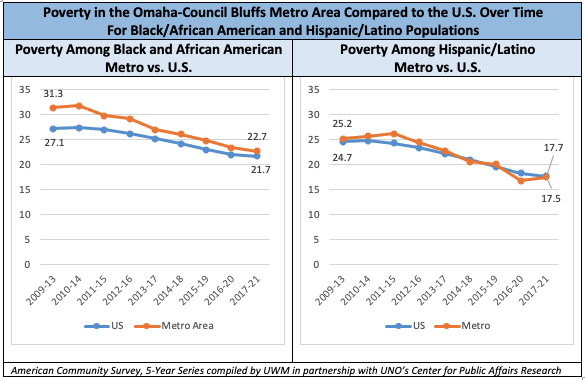A Look at Poverty in the Metro
It’s been 58 years since President Johnson launched a war on poverty in response to a national poverty rate around 19%. And while the U.S. poverty rate is now much lower, many of the outdated stereotypes persist. The story we often hear about poverty isn’t true.
The Strength and Resilience of the Working Poor
In the Omaha-Council Bluffs metro area, our poverty rate of 9.3% is well below the U.S. poverty rate of 12.6%.[i] But when we try to make sense of these numbers, we often fall into dangerous narratives. As one expert explains, “Some people tell the story that poor folks are lazy freeloaders who would cheat and lie to get out of an honest day’s work. Others prefer the story that poor people are helpless.”[ii]
In looking at the data and listening to families, we are reminded that these narratives do not accurately reflect the experience of people living in poverty – particularly in our metro area. The data shows that low-income households generally 1) include at least one worker and 2) foster resilience through a strong sense of togetherness and self-reliance.
Not every person in poverty is able to work, and some of the negative stories we hear are true. But those cases are not the norm. Data from the U.S. Census shows nearly 70% of households in poverty in our metro include at least one worker.[iii] Researchers often refer to this data point as a measure of a community’s working poor population. And the Omaha-Council Bluffs metro ranks among the worst when it comes to this metric. In other words, we have more working families living in poverty here than almost anywhere else in the country.
Low-income families often struggle to meet their basic needs, and lack many of the protective factors traditionally associated with resilience; they are also some of the hardest working people in our community.
A national study shows low-income families exhibit remarkable and unique strengths in the face of tough circumstances. This resilience stems from a sense of togetherness and confidence in problem- solving skills. When problems arise, they pull together and rely on each other. Social support connections also help low-income families buffer economic distress.[iv] Far from helpless, these families respond to adversity with grit.
Poverty is Decreasing, But Disparity Remains
There’s another story about poverty that’s often missed – it’s been on a fairly steady decline both locally and nationally for the last 10 years. For instance, in 2013 the poverty rate in the Omaha-Council Bluffs metro was 12.1% or roughly three percentage points higher than it is today[v].
Poverty rates among the area’s Black and Hispanic populations have seen even steeper declines. As shown below, these poverty rates has significantly declined over the last ten years and is relatively consistent with the U.S. average.

A Stronger Future
Last year was an extremely difficult year for family budgets due to the highest inflation we’ve seen in decades, and this has placed greater demands on both formal and informal support systems. There’s clearly more work to be done, and UWM is in a position to help.
As a steward of donor dollars, UWM can effect change by directing resources where they are needed most. This work evolves with the needs of the community. Data, thought leaders and families struggling to make ends meet inform our understanding of poverty, and the path to financial stability.
The region’s high levels of working poor shows that there is an opportunity to capitalize on high labor force participation and low unemployment. By investing in programs that reskill and upskill low-income families into living wage jobs, we can meet employer demands for high-skilled labor and create conditions for families to thrive.
Our community’s health and human services infrastructure forms a critical circle of supports both for families, and for the larger community. It is essential that our metro has a strong network of organizations to address widening social and economic disparities, and that we meet new challenges as they emerge. We’ve been investing in this safety net since 1923 to ensure community members can access opportunity, and provide the essentials for themselves and their family. And as we move forward into the next 100 years, UWM will continue to challenge our understanding of what currently exists, direct resources to impactful organizations, and unite our community for a stronger tomorrow.
Circle of Support

For more information about the impact of our investments, and how you can help click below.
Editor’s Note: January is Poverty Awareness in America Month
[i] American Community Survey, 2021 5-Year Data
[ii] Mia Birdsong is an activist and nonprofit leader whose Ted Talk “The Story We Tell About Poverty Isn’t True” has been viewed more than 2 million times.
[iii] American Community Survey, 2021 5-Year Data
[iv] Orthner, D. K., Jones-Sanpei, H., & Williamson, S. (2004). The Resilience and Strengths of Low-Income Families. Family Relations, 53(2), 159–167. http://www.jstor.org/stable/3700259
[v] American Community Survey, 2021 5-Year Data
[vi] American Community Survey, 2021 5-Year Data
[vii] 2023 Federal Poverty Guidelines, published by HHS: https://aspe.hhs.gov/topics/poverty-economic-mobility/poverty-guidelines
[viii] While a single poverty measure has the benefit of a shared framework, it fails to capture the income a family actually needs. Reputable research institutions across the U.S. have created family budget calculators to understand the income required to provide for basic needs in certain geographies. These include the Economic Policy Institute, MIT, Voices for Children and more. Adjusting for inflation, an average of these calculators show a family of four would need annual income of about $75,000 to fulfill a basic needs budget in our area.

About the Author
Lauren Kimball, MS, MPA, is the Senior Director for Community Impact and Analytics. In this role, she is responsible for leading UWM’s community research, data collection and evaluation – identifying needs and best practices to guide how we invest resources in the metro area. Lauren has more than 15 years of government and nonprofit experience, and her work has been published in numerous magazines, newspapers, and journals.